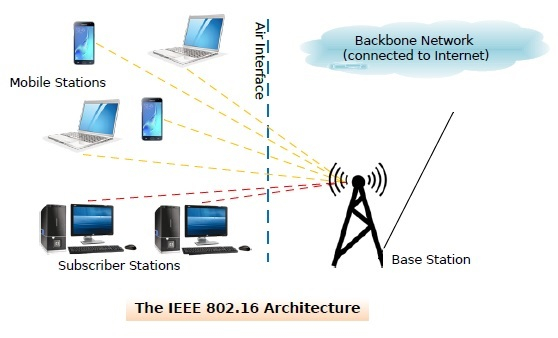
 Data Structure
Data Structure Networking
Networking RDBMS
RDBMS Operating System
Operating System Java
Java MS Excel
MS Excel iOS
iOS HTML
HTML CSS
CSS Android
Android Python
Python C Programming
C Programming C++
C++ C#
C# MongoDB
MongoDB MySQL
MySQL Javascript
Javascript PHP
PHPPhysics
Chemistry
Biology
Mathematics
English
Economics
Psychology
Social Studies
Fashion Studies
Legal Studies
- Selected Reading
- UPSC IAS Exams Notes
- Developer's Best Practices
- Questions and Answers
- Effective Resume Writing
- HR Interview Questions
- Computer Glossary
- Who is Who
The 802.16 Architecture
The IEEE 802.16 is a set of standards that lays down the specifications for wireless broadband technology. It has been commercialized as Worldwide Interoperability for Microwave Access (WiMAX) that is responsible for delivery of last mile wireless broadband access.
The IEEE 802.16 architecture lays down the standards for both physical layer as well as medium access control (MAC) layer for WiMAX. It initially provided data rates of 30 – 40 Mbps. The updated version that came in 2011 provides up to 1 Gbps data rates for fixed stations. It operates in the frequency band of 2 GHz to 11 GHz. The bandwidth is dynamically allocated as per user requirements.
Here, two types of user stations are there −
- Subscriber stations − They are stationary in some fixed location. For example, broadband Internet for homes and offices.
- Mobile stations − They receive service while they are in motion within the range of WiMAX. For example, a WiMAX equipped vehicle.
A user station connects wirelessly to the base station, forming the last wile of the broadband network through the air interface. The base station is responsible for initiating and controlling transmission of frames. Each frame can support both upstream and downstream data. The base station is connected to the backbone network of the broadband service provider. The backbone network is connected to Internet. The architecture is shown as follows −


